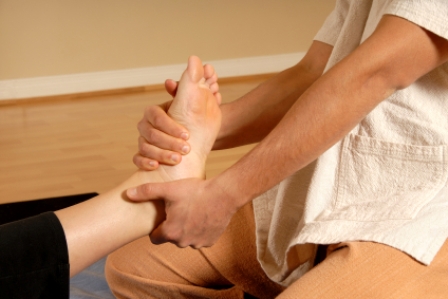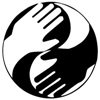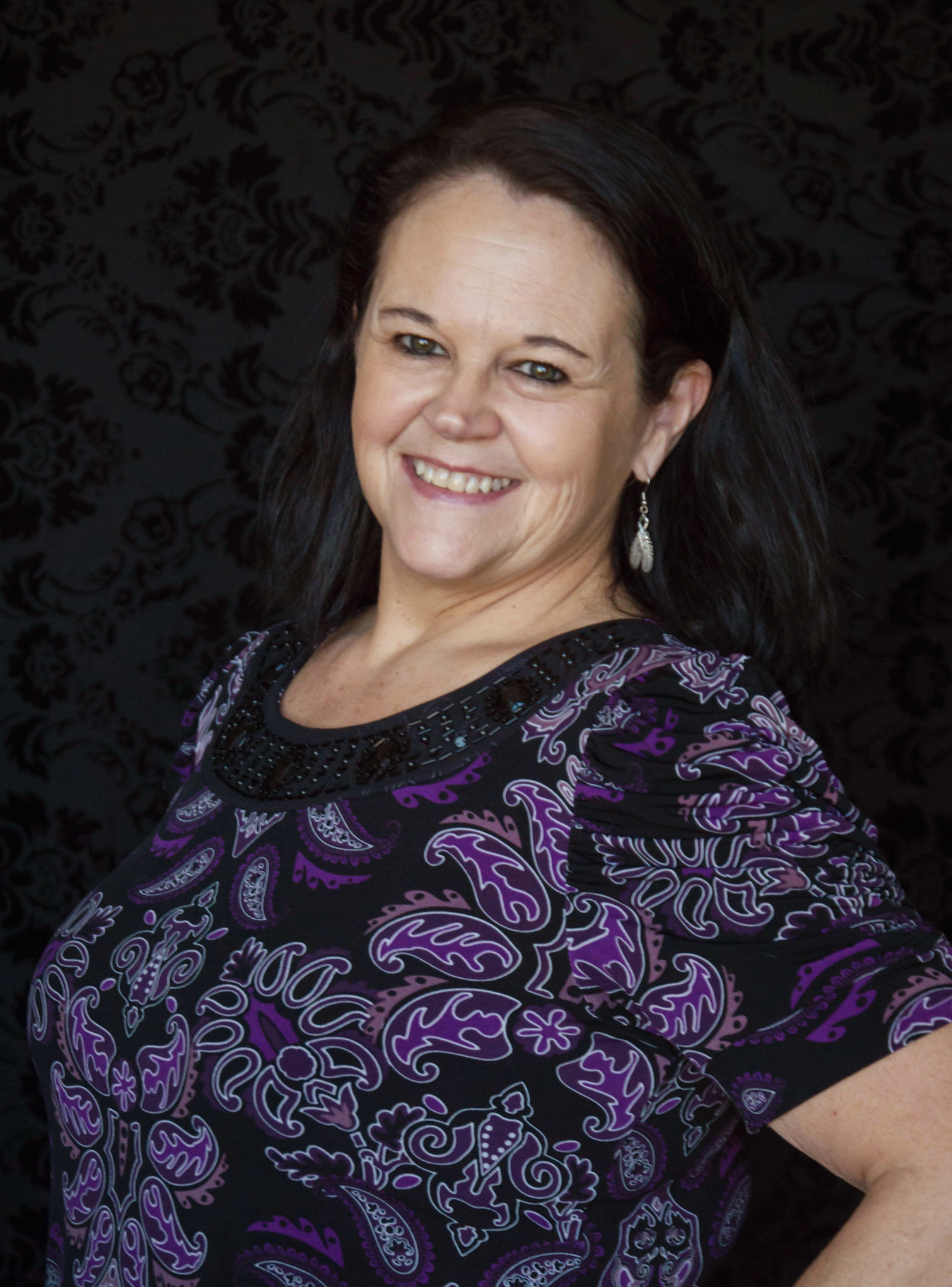Myofascial Release
If you think you’re experiencing a lot of pain in your muscles, think again.It might not just be your muscles that are causing the problems. It might be your fascia.
What's the fascia? It's the thin, connective tissue membrane that covers all of the muscles in your body, along with your organs and bones.
It forms one seamless structure that stretches from head to toe, and together with your muscles, makes up your myofascial system.
While "myofascial system" is a massive technical term that sounds like you might need a physiology degree to understand it, it's actually pretty simple.
Anything from stress to bad posture to an injury, inflammation or trauma can cause tightening in your fascia.
This damages your tissue, causes pain, makes it hard to move affected parts of the body and is just generally unpleasant.
 Performing Myofascial Release on a clients leg.
Performing Myofascial Release on a clients leg.Myofascial massage is especially designed to tackle those sorts of problems.
Myofascial massage is a form of soft tissue therapy that employs different methods including gentle, persistent pressure and mild stretching to loosen up tight spots in the myofascial system.
Manipulating these tissues stimulates them and encourages them to "release" and realign themselves in a healthier, more functional way.
This can ease pain and discomfort, soothe tense muscles, make joints more flexible and help to balance the body.
During a Myofascial Release treatment, the soft tissue is lightly stretched and held under light pressure for a period of 3-5 minutes until it "releases".
At the moment of release, the therapist feels a pulse of heat from the tissue, and can also feel it soften and become more flexible under his or her hand.
Our technicians are well trained in this complex technique, so you can feel totally and completely confident in your myofascial treatment. Even if you can't quite pronounce it!
Sign up for your Massage Session TODAY!
The History of Myofascial Release Therapy
The word "myofascial" was originally coined in the 1940s by Janet G. Travell M.D. Travell wasn't just a pioneering researcher.
She was also the personal physician to President John F. Kennedy – the first woman ever to hold that position.
Dr. Travell came up with the term myofascial while researching so-called "trigger points" that were linked to musculoskeletal pain.
She continued this research throughout her career, coining the phrase "Myofascial Trigger Point" in 1976 and publishing her extensive study of the subject, titled "Myofascial Pain & Dysfunction: The Trigger Point Manual" in 1983.
Meanwhile, in 1981, a group of physical therapists and osteopaths were developing their own take on the whole myofascial subject.
They coined the term Myofascial Release to describe a gentle method of stretching that could be successfully used to ease tension in the fascia without the harsher effects of direct manipulation.
Physical therapist John C. Barnes popularized the method in the '90s through a series of seminars that are well known throughout the PT, or physical therapy, industry. His method encourages a gentle "unwinding" of tight, painful tissue.
Sign up for your Massage Session TODAY!
What to Expect from your Myofascial Release Treatment
While the concept of Myofascial Release may sound complicated, when you come to Power Therapeutic Massage for your treatment, you are in good hands.
Your massage therapist will work with you to determine just where your trouble spots are, and what the best method will be to tackle them.
Your treatment will take place in private, in a quiet room designed especially for your relaxation. You will probably lie on a massage table as your therapist gently stretches your muscles.
The treatment will feel as if your therapist is performing your stretching exercises for you, while you simply lie there and enjoy the benefits.
It may feel a little bit like you’re cheating, but in reality, you’ll be doing something wonderful for your body by turning it over to a skilled technician.
You will leave feeling relaxed, with new movement and freedom in the affected parts of your body.
Sign up for your Massage Session TODAY!
What Others are Saying about Myofascial Release
"Myofascial Release is the "missing link" in health care since it is successful in releasing the cross-links and rehydrating the ground substance. This rehydration of the ground substance allows for a complete release all the way down to the cellular level."
John Barnes, P.T., L.M.T., N.C.T.M.B., is an acknowledged expert in the area of Myofascial Massage. He has instructed thousands of therapists worldwide in his Myofascial Release Approach, and he is the author of Myofascial Release: the Search for Excellence (Rehabilitation Services, Inc, 1990) and Healing Ancient Wounds: the Renegade's Wisdom (MFR Treatment Centers & Seminars, 2000). Barnes is on the Counsel of Advisors of the American Back Society; is an editorial advisor to the Journal of Bodywork and Movement Therapies; and is a member of the American Physical Therapy Association
"So much pain stems from myofascial trigger points. It is far more common than tendinitis, nerve compression or herniated discs. It drives people from doctor to doctor in search of relief. And people end up swallowing untold numbers of analgesics and NSAIDs in order to rid themselves of it. The degree of relief that can be provided through the appropriate use of trigger point release techniques should not be underestimated. Through true understanding and precise use, the work that we provide can be of enormous benefit."
Donna Finando, L.Ac., L.M.T. is co-author with Steven Finando of Trigger Point Therapy for Myofascial Pain, The Practice of Informed Touch (Healing Arts Press, 1999, 2005). She is the author of Trigger Point Self Care Manual (Healing Arts Press, 2005) and Acupoint and Trigger Point Therapy for Babies and Children (Healing Arts Press, 2008). Finando maintains a private practice on Long Island, New York, where she’s lived and worked for more than 30 years.
Sign up for your Massage Session TODAY!
Recommended Reading
To learn more about Myofascial Release, check out one of these books.
Hardcover and Paperback Books
- Travell, Janet G. & Simons, David G. (1999) Myofascial Pain and Dysfunction: The Trigger Point Manual. Mediatrition. ISBN-0683307711
Janet Travell, MD and David Simons, MD were absolute pioneers when it came to myofascial pain and it's treatment. What makes these books even more amazing is that they were written a full quarter of a century before doctors even acknowledged that myofascial pain actually exsisted. They go into strong detail as to stroke, direction and stretching.
- Barnes, John F. (1990) Myofascial Release: The Search for Excellence. ISBN-1929894007
John F. Barnes is the President and Director of the Myofascial Release Treatment Centers and Seminars. His book is about treatment of the fascial system. It offers explanations of how myofascial release works so consistenty and effectively and provides healthcare providers with excellent techniques that will allow them to treat the whole person.

Open Monday through Friday 8 am - 6 pm.
Saturday by appointment.
Power Therapeutic Massage
Suite B
Effingham, IL 62401
Get Directions
Advanced reservations are appreciated, but last-minute bookings may be available. Please call for availability. In case of cancellation please give 6 hours notice.
Most Popular Massages

